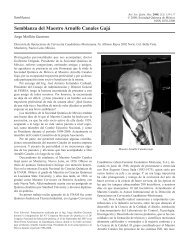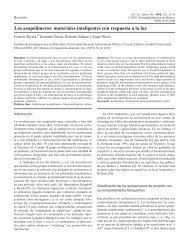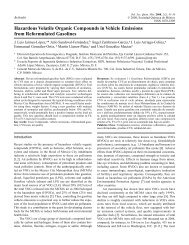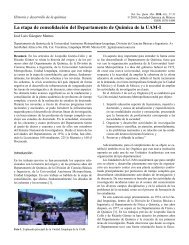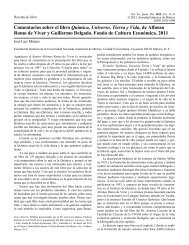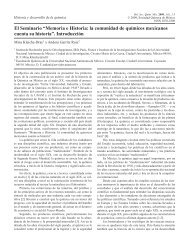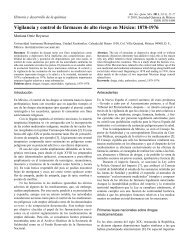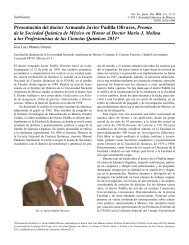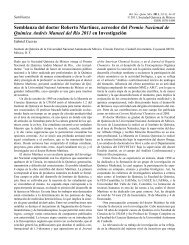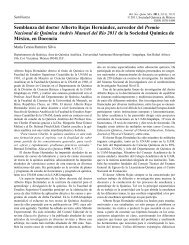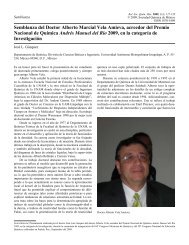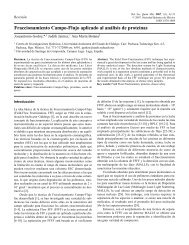A New Generalized Matrix Inverse Method for Balancing Chemical ...
A New Generalized Matrix Inverse Method for Balancing Chemical ...
A New Generalized Matrix Inverse Method for Balancing Chemical ...
You also want an ePaper? Increase the reach of your titles
YUMPU automatically turns print PDFs into web optimized ePapers that Google loves.
A <strong>New</strong> <strong>Generalized</strong> <strong>Matrix</strong> <strong>Inverse</strong> <strong>Method</strong> <strong>for</strong> <strong>Balancing</strong> <strong>Chemical</strong> Equations and their Stability 111<br />
of the spectral theorem to arbitrary, not necessarily square<br />
matrices. Since, the matrix A has a matrix of eigenvectors<br />
that is not invertible, i. e., the matrix A does not have an eigen<br />
decomposition, then A can be presented by its singular value<br />
decomposition. The von Neumann pseudoinverse A N of the<br />
matrix A determined by the <strong>for</strong>mula A N = (V T ) -1 diag(1/d 1 ,…,<br />
1/d 8 , 0)U -1 is<br />
⎡ 0.101523256567670 0.321803887120054<br />
⎢ -0.045223147018723 2.643569604152050<br />
⎢ 0.061229664532195 -2.769586211377240<br />
⎢ -0.047374220591932 0.136340300180892<br />
A N = ⎢ -0.025538092341311 0.253565957729192<br />
⎢ 0.012613778846674 0.330397410308811<br />
⎢ 0.012633132259008 -0.919353959433015<br />
⎢ -0.034251335322107 1.751346157688120<br />
⎣ -0.026853724152914 1.433111472758320<br />
-0.288108429146632 -1.188150902038370<br />
-2.485818145278540 -1.420833955106290<br />
2.597366632008940 1.882364109752350<br />
-0.079944559167976 -0.379557722145593<br />
0.569019045271805 -1.535863922093850<br />
-0.413165815277642 0.435071248156406<br />
0.836975164068040 0.435222179359037<br />
-1.633950741785980 -1.074035211448490<br />
-1.271285637926960 -0.911850350422177<br />
0.610923180005891 0.305461590002947<br />
-0.658983155079063 -0.450181232711944<br />
0.420984017508641 0.331181663926733<br />
0.217976731579250 0.108988365789626<br />
0.679224462547416 0.339612231273709<br />
-0.258919826562618 -0.129459913281308<br />
0.241199512637992 0.120599756318995<br />
-0.335319169083302 -0.245245791438202<br />
-0.187299838407709 -0.153994746790060<br />
-0.289337204026299 0.033695457973420<br />
-0.316562029131021 0.157751458873511<br />
0.428607651725322 -0.172219579368304<br />
-0.331619544143528 0.056395741012914<br />
-0.178766646389184 -0.177414996999005<br />
0.088296451926710 -0.082768404968829<br />
0.088431925813047 -0.082378795364977<br />
-0.239759347254723 0.117395415902143<br />
-0.187976069070377 0.161825834831369<br />
0.610923180005892 ⎤<br />
-0.038293499906653 ⎥<br />
-0.199705637663771 ⎥<br />
0.217976731579252 ⎥<br />
0.679224462547419 ⎥.<br />
-0.258919826562618 ⎥<br />
0.241199512637993 ⎥<br />
-0.007732962186752 ⎥<br />
-0.376955010821503 ⎦<br />
Required coefficients of the chemical equation (5. 2),<br />
according to the <strong>for</strong>mula (4. 9) are<br />
⎡x 1 ⎤ ⎡1⎤ ⎡0.087194107660614⎤.<br />
x 2 1 1.120169049513394 .<br />
x 3 1 0.635162835008073 .<br />
x 4 1 0.679999542439780 .<br />
x 5 = (I - A N A) 1 = 0.537666171040854 .<br />
x 6 1 0.268833085520413 .<br />
x 7 1 0.610358753624375 .<br />
x 8 1 1.755331884521518 .<br />
⎣x 9⎦ ⎣1⎦ ⎣0.537666171040864⎦.<br />
Now balanced chemical equation (5. 2) obtains this <strong>for</strong>m<br />
0.087194107660614[4Yb(CN) 3·3Yb(CN) 2 ]<br />
+ 1.120169049513394CsRu(CN) 2 F 2<br />
+ 0.635162835008073CsRu(CN) 4<br />
+ 0.67999954243978CsHF 2<br />
+ 0.537666171040854[PtF 3·7H 2 O]<br />
= 0.268833085520413[Pt(NH 3 ) 2 (C 5 H 4 ON)] 2 (NO 3 ) 2·2H 2 O<br />
+ 0.610358753624375Cs 3.99 Yb(CN) 6<br />
+ 1.755331884521518HRuF 2.97<br />
+ 0.537666171040864NO 2 .<br />
If we multiply above equality by 454159.1291252759 we<br />
obtain the equality in its conventional <strong>for</strong>m<br />
39600[4Yb(CN) 3·3Yb(CN) 2 ] + 508735CsRu(CN) 2 F 2<br />
+ 288465CsRu(CN) 4 + 308828CsHF 2<br />
+ 244186[PtF 3·7H 2 O]<br />
= 122093[Pt(NH 3 ) 2 (C 5 H 4 ON)] 2 (NO 3 ) 2·2H 2 O<br />
+ 277200Cs 3.99 Yb(CN) 6 + 797200HRuF 2.97 + 244186NO 2 .<br />
The eigenvalues of the matrix (A + A T )/2 are<br />
λ 1 = -18.060777308031500, λ 2 = 20.041652979700600,<br />
λ 3 = 14.665879176680500, λ 4 = -5.617846328393410,<br />
λ 5 = 2.319213465566350, λ 6 = -1.937661578812980,<br />
λ 7 = 1.071305345298540, λ 8 = -0.696805962104278,<br />
λ 9 = 0.215040210096249.<br />
The Lozinskii measures of A given by (3. 12) with respect<br />
to the three common norms (3. 11) are<br />
µ ∞ (A) = max (8, 40, 39, 6.99, 3, 9.97, 40, 3, 15) = 40,<br />
µ 1 (A) = max (43, 8, 10, 4, 25, 54, 16.99, 4.97, -1) = 54,<br />
µ 2 (A) = λ 2 = 20.041652979700600.<br />
Since µ 2 (A) > 0 and definition 4. 5 immediately follows<br />
that the chemical equation (5. 2) is unstable.<br />
With this method we balanced successfully lot of chemical<br />
equations and some of them are given below as examples.<br />
The research shown that considered chemical equations are<br />
unstable too.



